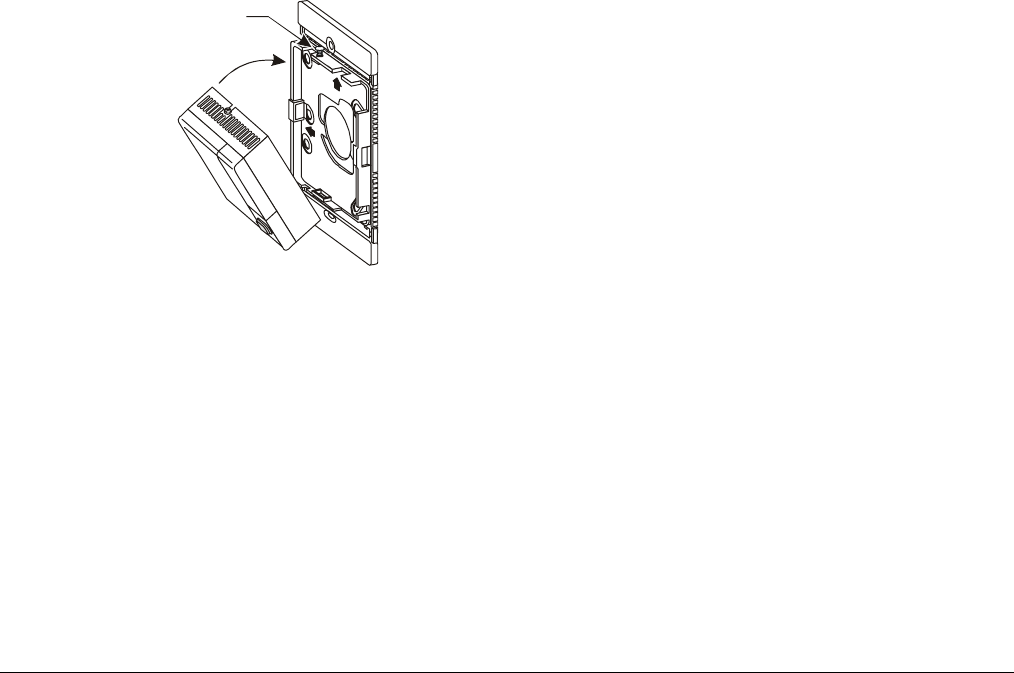User Manual

6 WRS-TTx Series Radio Frequency (RF) Wireless Transmitters Installation Instructions
3. View the Property Code and Transmitter ID DIP
switch arrays on the back of the transmitter.
For a One-to-One application, set the Property
Code DIP switch array to all “Zeros.” Set the
address portion of the Transmitter ID DIP switch
array to match the corresponding TE-78XX
receiver DIP switch array.
For a Many-to-One application, set the Property
Code DIP switch array (1 to 31) and the address
portion of the Transmitter ID DIP switch array (1 to
511) to desired addresses for the designated
locations. (A “zero” setting is not allowed.) These
addresses will be downloaded via the NAE to a
WRS-RTN and be linked with specific Controllers.
See the Setup and Adjustments section for more
details.
4. Install the battery into the battery compartment
located on the back of the transmitter, and set the
power DIP switch (top DIP switch on the
Transmitter ID DIP switch array) to the ON
position.
5. Place the bottom edge of the transmitter against
the bottom lip of the mounting base and rotate the
transmitter up onto the mounting base (as
illustrated in Figure 6).
Tamper-Proof
Transmitter Cover
Holding Screw
Note: This diagram needs to be replaced with
appropriate 80 X120 cover and base diagram
Figure 6: Securing the Transmitter to the
Mounting Base
6. Tighten the tamper-proof transmitter cover holding
screw using a 1/16 in. (2 mm) Allen-head
adjustment tool (T-4000-119; ordered separately)
to secure the transmitter to the mounting base.
Note: Once installed, the transmitter and
mounting base assembly cannot be removed from
the mounting surface without first loosening the
tamper-proof transmitter cover holding screw and
then depressing the tab at the top through the slot
using a small coin or a screwdriver. (as illustrated
in Figure 2).
Setup and Adjustments
For setup and commissioning details, refer to the
WRS-TTx Technical Bulletin (LIT-??????????)
Repairs and Replacement
If the WRS-TTx Series RF Wireless Temperature and
Set Point Transmitter, or the TE-7720 or
TE-7730 Series RF Receiver, or the WRS-RTN Series
RF Receiver fails to operate within its specifications,
unit replacement is required. For a replacement
transmitter or receiver, contact the nearest
Johnson Controls representative.
Table 2 includes the only replacement parts available
for the WRS Series RF Wireless Room Temperature
Sensing System. Do not attempt any repairs on the
temperature sensing system other than those related
to the replacement parts included in Table 2.
Note: The printed circuit board used with the
WRS Series RF Wireless Room Temperature Sensing
System is retained with a tamper-resistant mechanism.
Removing the printed circuit board from the plastic
housing voids the product warranty.
Replacing the Transmitter Battery
The life of the 1.5-volt AA Alkaline batteries included
with each WRS-TTx Series Transmitter is typically five
or more years. The transmitter communicates
diagnostic data, including battery condition,
approximately every 60 seconds to the receiver, where
it is converted into the appropriate units and electrical
format to warn supervisory equipment (via the
Johnson Controls digital controller) when the batteries
needs to be replaced.
For the WRS-RTN Series Receiver, a low battery
signal is sent to the NAE via the Ethernet trunk, and
this signal is not cleared until the transmitter battery is
replaced. For the TE-7820 Series Receiver, a low
battery signal is sent to the digital controller via the
zone bus link, and this signal is not cleared until the
transmitter battery is replaced.
For the TE-7830 Series Receiver, the low battery relay
binary output is turned off for 1 minute every 48 hours
and then back on again. This function is intended to
retrigger a system alarm that may have been
acknowledged without taking appropriate action to
replace the transmitter battery.
See Figure 2 to remove the transmitter from its
mounting base and access the battery for
replacement. Replacement batteries must be
purchased locally; suitable models include any good
quality Alkaline (1.5V) or Lithium (1.6V) AA cells. Do
not use Carbon/Zinc batteries as these will give a poor
life and could give erratic operation.









